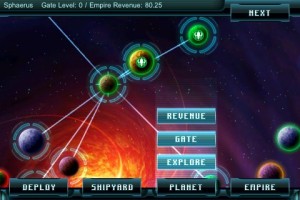 Command and Conquer!
Command and Conquer!
Humanity had a grand old time exploring the cosmos — right up until it collided with such space-grabbing alien competitors as the Reticulans, Harpuia, Dev’orn, and Scarab, and the disappointment was most assuredly mutual. When this happened to the Romans a few eons back, the battle cry used to be Vae Victis (“woe to the vanquished”); in the space faring age, it’s Vincere Totus Astrum (“to conquer all stars” — and it’s Out Now, $1.99). After choosing one of the five species to command, the player proceeds to build a galactic empire and eliminate all competition to his or her people’s expansion. For better or worse Vincere‘s story begins and ends there, with the player slogging only through the text of periodic status reports and forgettable parting messages from conquered species. I do mean “slog”, as the game’s text is regrettably teeming with odd grammar. A bug in the universal translator, perhaps?
Far more satisfying than Vincere‘s attempt at building a solid premise is the depth of its imperial micromanagement. The lion’s share of it is spent deciding whether individual planets in the player’s burgeoning possessions should be devoted to revenue generation, building up defenses, launching attacks, or producing and transporting warships, among a plethora of other actions. Inasmuch as the focus is squarely on military management and not equally on civilian duties, Vincere doesn’t become quite as involved as other games in the “4X” strategy subgenre. Nevertheless, players will still want to spend plenty of time sifting through a “How to Play” instructional accessible on the starting menu, as Vincere lacks a live tutorial.
 And a live tutorial, or at least an update to flesh out the static one already on offer, is something Vincere needs badly. In the release version Gamesare has skimped on some important details, such as how Gate jumps work exactly, and how many heavy battleships a planet can have floating in its space docks. That several critical nuances must be discovered through pure trial and error is frustrating, but once the strategy fan has everything down pat, he or she will enjoy planning out ship production and swapping battle fleets among planets as the situation demands. Imperial management occurs in turns, each one ending when the player has assigned an action to every planet in his or her galactic empire. Rewarding the player’s progress with more resources and actions per turn becomes a winning formula, but on the other hand, a shortcut button to mass-assign common actions would be most welcome. When the player has twenty to thirty planets in his or her holdings and needs most to focus on revenue production or shipbuilding, the one-by-one “next” button simply doesn’t cut it. Nor can the player undo assigned actions before the turn ends. It makes enough sense that an attack order on an enemy planet can’t be recalled, but having the ability to otherwise cancel mistaken assignments would be nice.
And a live tutorial, or at least an update to flesh out the static one already on offer, is something Vincere needs badly. In the release version Gamesare has skimped on some important details, such as how Gate jumps work exactly, and how many heavy battleships a planet can have floating in its space docks. That several critical nuances must be discovered through pure trial and error is frustrating, but once the strategy fan has everything down pat, he or she will enjoy planning out ship production and swapping battle fleets among planets as the situation demands. Imperial management occurs in turns, each one ending when the player has assigned an action to every planet in his or her galactic empire. Rewarding the player’s progress with more resources and actions per turn becomes a winning formula, but on the other hand, a shortcut button to mass-assign common actions would be most welcome. When the player has twenty to thirty planets in his or her holdings and needs most to focus on revenue production or shipbuilding, the one-by-one “next” button simply doesn’t cut it. Nor can the player undo assigned actions before the turn ends. It makes enough sense that an attack order on an enemy planet can’t be recalled, but having the ability to otherwise cancel mistaken assignments would be nice.
In addition to building up his or her empire’s military, the player must decide which technologies the empire’s scientists should research. Only one technology may be developed at any given time, and how many turns the research takes depends on how adept the player’s chosen civilization is in this area. It’s too bad that this aspect of gameplay isn’t developed to its fullest potential; the civilizations appear to share the exact same classes of warships, weaponry, and most other technologies. Once developed, certain technologies reappear on the player’s menu of development choices without the player knowing for sure if the skill is something that can be leveled up, or if – like attempting to house more than the secret max allotment of heavy ships in one planet’s space dock – it’s something that the player could be wasting turns on entirely.
 While combat certainly isn’t the only option for handling unfriendly planets on the player’s imperial border – envoys can be sent to pacify what would otherwise become a front line combat zone – it is the most fun. Vincere does something very welcome in combining pre-planning with real-time player interaction once an assault squadron has been launched. Success in battle doesn’t just depend on the offense and defense ratings of planets from which attacks are launched or repelled. While his or her standard warships are surging into battle, the player engages in a rock-paper-scissors style affair in selecting battle formations and direction of fire to best counter enemy choices made known at the same time. Once player and enemy strategies are selected and the battle begins, the player times his or her Galaga-ish fleet’s use of primary and available secondary weapons, and does the same for heavy battleships that can be called upon for backup if the dispatching planet has them on-hand. Battles complete the other half of Vincere‘s winning gameplay formula, but sadly they suffer from the same drawbacks as the game’s management aspect: nuances are discovered through precarious trial and error, and there’s no “undo” button for accidental selections.
While combat certainly isn’t the only option for handling unfriendly planets on the player’s imperial border – envoys can be sent to pacify what would otherwise become a front line combat zone – it is the most fun. Vincere does something very welcome in combining pre-planning with real-time player interaction once an assault squadron has been launched. Success in battle doesn’t just depend on the offense and defense ratings of planets from which attacks are launched or repelled. While his or her standard warships are surging into battle, the player engages in a rock-paper-scissors style affair in selecting battle formations and direction of fire to best counter enemy choices made known at the same time. Once player and enemy strategies are selected and the battle begins, the player times his or her Galaga-ish fleet’s use of primary and available secondary weapons, and does the same for heavy battleships that can be called upon for backup if the dispatching planet has them on-hand. Battles complete the other half of Vincere‘s winning gameplay formula, but sadly they suffer from the same drawbacks as the game’s management aspect: nuances are discovered through precarious trial and error, and there’s no “undo” button for accidental selections.
Vincere‘s virtual controls handle reliably despite how thin some of its virtual buttons are. User interface complaints are most likely to focus on how slivery the in-battle firing controls are, as well as a lack of touch sensitivity when it comes to scrolling the game’s galaxy map — a frustration handily intensified by lack of options to mass-assign an action to multiple planets. I experienced occasional stability issues on my iPod Touch 4, software version 4.3.3, although the game’s auto-save takes the sting out of this. Symptoms ranged from outright crashes to loss of UI sensitivity and sound effects. Ironically the auto-save that happens just prior to a battle seemed to be the main culprit for me, so manual saves before ordering a fleet to attack are highly recommended until the issue is eliminated in future updates.
Vincere‘s visuals and music are all perfectly suited to the tour-de-force effort it tries desperately to be, and especially impressive in light of the fact that Vincere is a two-man effort! One playthrough of the game’s Campaign Mode should be expected to last ten to fifteen hours, with different modes and difficulty levels offering various starting scenarios; these are where some substantive replay value is to be found, rather than in civilization selection. Given its incredibly light story, Vincere could have made use of Game Center or OpenFeint achievements to help emphasize player progression, but sadly the release version doesn’t seize on that opportunity.
iFanzine Verdict: Strategy fans of all preferences would do well to look into Vincere Totus Astrum, and it’s especially recommended to those who enjoy a heavy helping of civilization management when they’re not hammering away at enemy forces. Lack of convenient niceties like thorough tutorials and easy cancellation of player error, as well as a practically self-defeating attempt at a plot, rob it of the more general audience it might have seized otherwise. [xrr rating=3.5/5]


